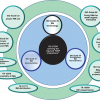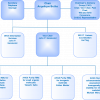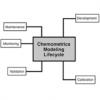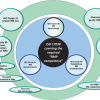John P. Hammonda and Chris Burgessb
aStarna Scientific Limited, 52/54 Fowler Road, Hainault, Essex, IG6 3UT, UK. E-mail: john.hammond@starna.com
b’Rose Rae’, The Lendings, Startforth, Barnard Castle, Co Durham DL12 9AB, UK.
E-mail: chris@burgessconsultancy.co.uk
Those of you who read this column regularly will know that the contributing editors frequently make reference to the misunderstandings, and misapprehensions that appear to surround the terminology used in the science of “Quality” and all its ramifications. To give just one example, the debate over the term “commutability”, where, and how, it should be used continues as we speak, and will probably constitute the main text of a future column; when, and perhaps more appropriately “if” a consensus view can be achieved.
Recently, you will recall Peter Jenks clarifying the definition of a Primary Reference.1 This scenario can be repeated on a regular, almost daily basis where there is clearly an issue relating to the whole terminology associated with “Quality”, and more specifically, the classification of Reference Materials.
Coincidentally, as part of the extensive revision of the ISO/REMCO Guides previously reported, there is a new, extensively revised version of the ISO/REMCO Guide 30 that was last formally published in 1992, and amended for the key definitions of Reference Materials and Certified Reference Materials in 2008. This new Reference materials — Selected terms and definitions has recently been voted on within ISO, and will be discussed at the meeting of ISO/REMCO in Boulder, USA, July 2014.
The proposed scope of this document states:
“This Guide recommends terms and definitions that should be assigned to them when used in connection with reference materials, with particular attention to terms that are used in reference material certificates and corresponding certification reports.”
and is divided into these four key sections:
- Terms related to materials,
- Terms related to measurement and testing,
- Terms related to certification and issuance of reference materials,
- Statistical terms used in the characterisation of reference materials.
Returning to these key definitions of Reference Material and Certified Reference Material, the above document proposes defining these terms as below.
Reference material (RM)
“material, sufficiently homogeneous and stable with respect to one or more specified properties, which has been established to be fit for its intended use in a measurement process.”
The properties can be quantitative or qualitative, e.g. identity of substances or species, and uses may include the calibration of a measurement system, assessment of a measurement procedure, assigning values to other materials and quality control.
ISO/IEC Guide 99:2007 has an analogous definition (5.13), but restricts the term “measurement” to apply to quantitative values. However, Note 3 of ISO/IEC Guide 99:2007, 5.13 (VIM), specifically includes qualitative properties, called “nominal properties”.
Certified reference material (CRM)
“RM characterized by a metrologically valid procedure for one or more specified properties, accompanied by a certificate that states the value of the specified property, its associated uncertainty, and a statement of metrological traceability.”
The concept of value includes nominal property or attribute such as identity or sequence. Uncertainties for such attributes may be expressed as probabilities or levels of confidence.
Metrologically valid procedures for the production and certification of reference materials are given in, among others, ISO Guides 34 and 35. ISO Guide 31 gives guidance on the contents of certificates, and ISO/IEC Guide 99:2007 has an analogous definition (5.14).
Candidate reference material
“material, intended for future use as an RM.”
A candidate material has yet to be characterised and tested to ensure that it is fit for use in a measurement process To become an RM, a candidate reference material needs to be characterised to determine if it is sufficiently homogeneous and stable with respect to one or more specified properties, and is fit for its intended use in the development of measurement and test methods that target those properties.
So, as you can see, the basic requirements for any RM in the latest version of ISO Guide 30 is an appropriate evaluation of both the two key parameters of homogeneity and stability.
This requirement is also explicitly stated in the proposed revision of ISO Guide 31, where in the Introduction it states;
“According to the definition of a RM in ISO Guide 30 information on the homogeneity and stability of the material is required. Moreover, it is mandatory for a CRM that all certified values are accompanied by an uncertainty at a stated level of confidence and a statement on the metrological traceability of these values. Therefore, guidance on the content and the format of the information that accompanies a reference material, whether it is certified or not, is required.”
To expand and explain these definitions further:
As stated above, RM is a generic term, and therefore applies to all materials. In 2004, H. Emons, T.P.J. Linsinger and B.M. Gawlik published an article titled “Reference materials: terminology and use. Can’t one see the forest for the trees?”.2
In this article they state:
“According to these definitions, CRMs form a sub-group of RMs, namely those RMs that possess additional characteristics, namely a certificate and traceable assigned values with an uncertainty statement.”
They also stated that:
“The problem is that no name for the other sub-group of RMs have been defined (i.e., the one without a certificate and traceable assigned values).”
In the absence of such a definition, two approaches have been used. First, the term RM has been used for not only the main category but also the sub-category of non-certified RMs (e.g., the terminological hierarchy of Lumley and Walker3—see Figure 1), and, second, materials are defined by their use, i.e., as “Proficiency Testing Material”, “Laboratory Reference Material” or “Quality Control Material”.

So here you can see the problem. Being facetious,
“... when is an RM, not an RM—when it is a CRM”.
The problem with both these approaches lies in neglecting the fact that a specific use requires certain material characteristics, which are not explicitly attributed to the various categories of RM, i.e. any use of a material must be preceded by a definition of its characteristics, as they determine whether or not a material is ‘‘fit for purpose’’.
In Peter’s Primary Reference article1 he also describes the level of materials below those of the Primary and Secondary References as in-house or working reference materials.
The preparation of reference materials for metrological quality control (i.e. control of the quality of measurements not products) is an important activity which provides materials suitable for the day-to-day demonstration that a particular (part of a) measurement system is under statistical control. Such materials do not require characterisation by metrologically valid procedures, and can be prepared “in-house”, i.e. by laboratory staff familiar with their behaviour, to fulfil specific quality control requirements.
Reference materials which are sufficiently homogeneous and stable are necessary for metrological quality control purposes, such as demonstrating a measurement system is under statistical control, performs as expected and provides reliable results; where the trueness of the measurement result is not critical. Different industries use various terminologies to describe such materials (e.g. in-house reference materials, quality control materials, check samples etc.).
Again, as previously reported, ISO/REMCO has ready for publication, ISO Guide 80—“Guidance for in-house preparation of RMs for internal quality control”, where the term used for these RMs is “Quality Control Materials” (QCMs).
While CRMs are produced by established reference material producers and are commercially available, QCMs are often prepared by a laboratory for its own internal use. Frequently, QCMs are characterised only for a limited scope (a limited number of property values) and for specific laboratory applications.
The rationale for preparing quality control materials can be one or a combination of the following factors:
- to have a RM representing as closely as possible routine samples, suitable for quality control;
- to have a suitable day-to-day RM to complement a commercially available CRM;
- no suitable CRM exists;
- the application does not require a material having the full characteristics of a CRM (e.g. traceability and uncertainty for specified property values).
This hierarchy is graphically shown in Figure 2.

So now having now (hopefully) clarified the definitions and scope of the materials encompassed under the Reference Material name, the follow-up article to this will answer just a few of the frequently asked questions (FAQs) relating to this topic.
References
- P. Jenks, “What is a ‘Primary Standard’?”, Spectrosc. Europe 26(1), 26 (2014). http://bit.ly/SaSe6g
- H. Emons, T.P.J. Linsinger and, B.M. Gawlik, “Reference materials: terminology and use. Can’t one see the forest for the trees?”, Trends Anal. Chem. 23, 442 (2004). doi: http://dx.doi.org/10.1016/S0165-9936(04)00604-1
- R. Walker and I. Lumley, “Pitfalls in terminology and use of reference materials”, Trends Anal. Chem. 18, 594 (1999). doi: http://dx.doi.org/10.1016/S0165-9936(99)00158-2










